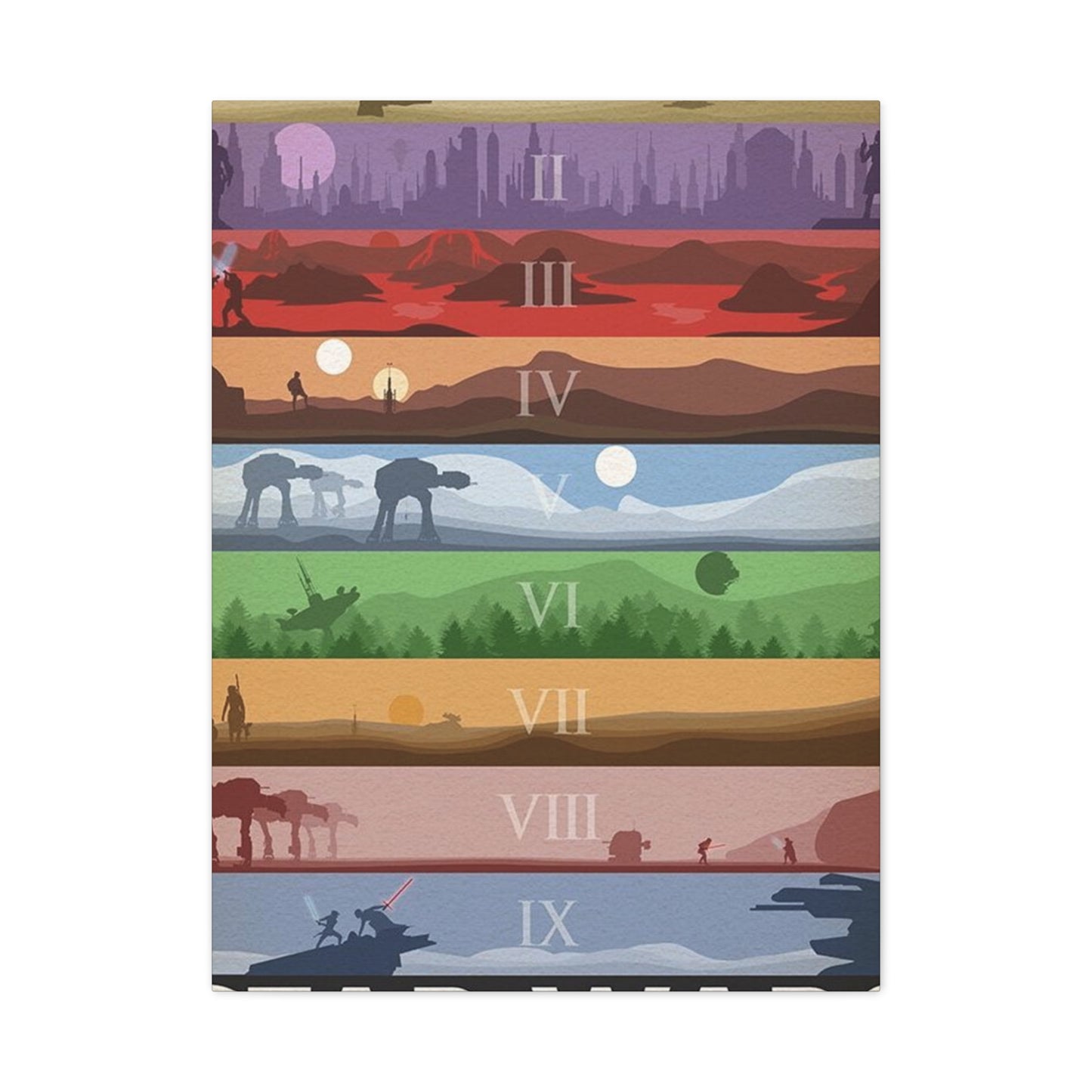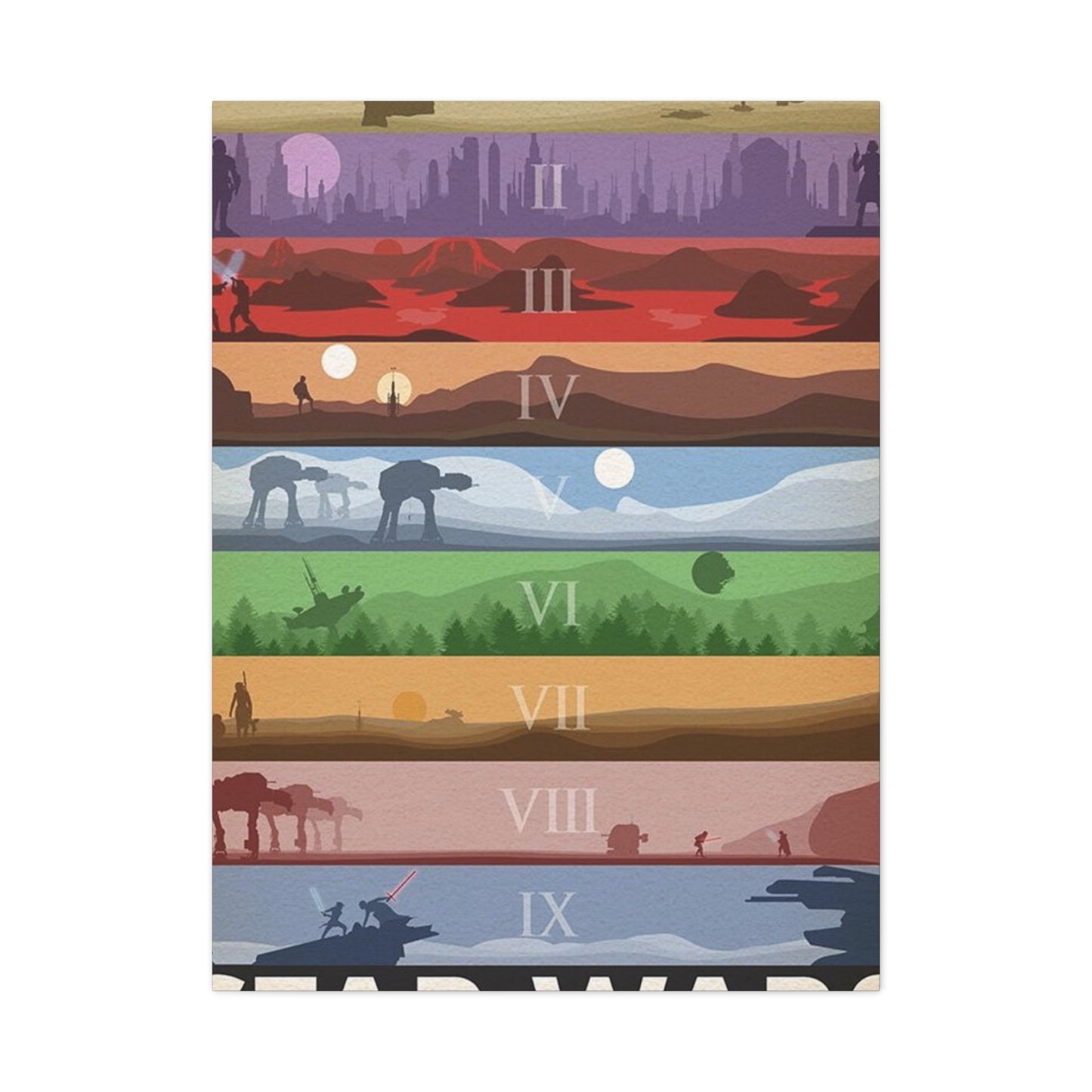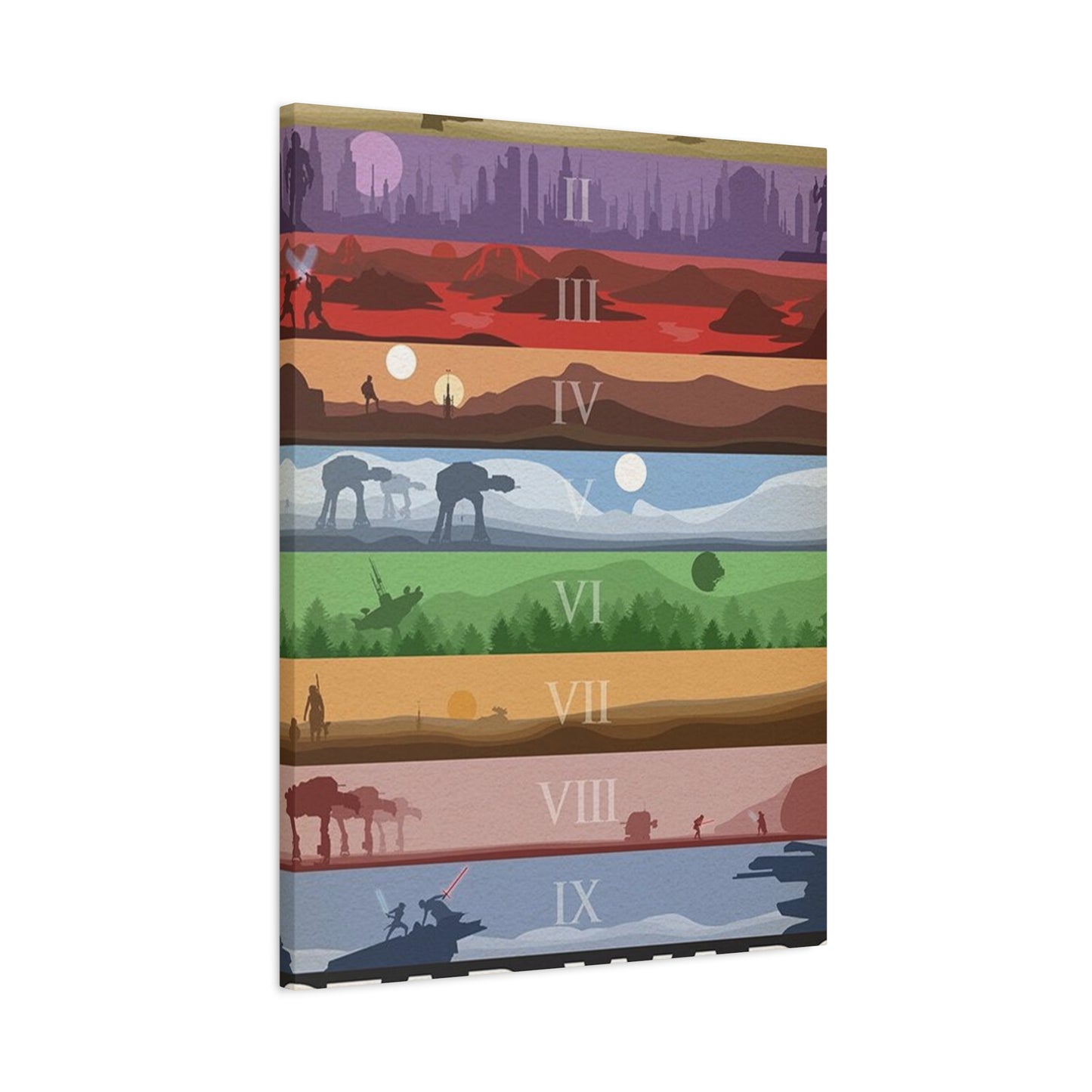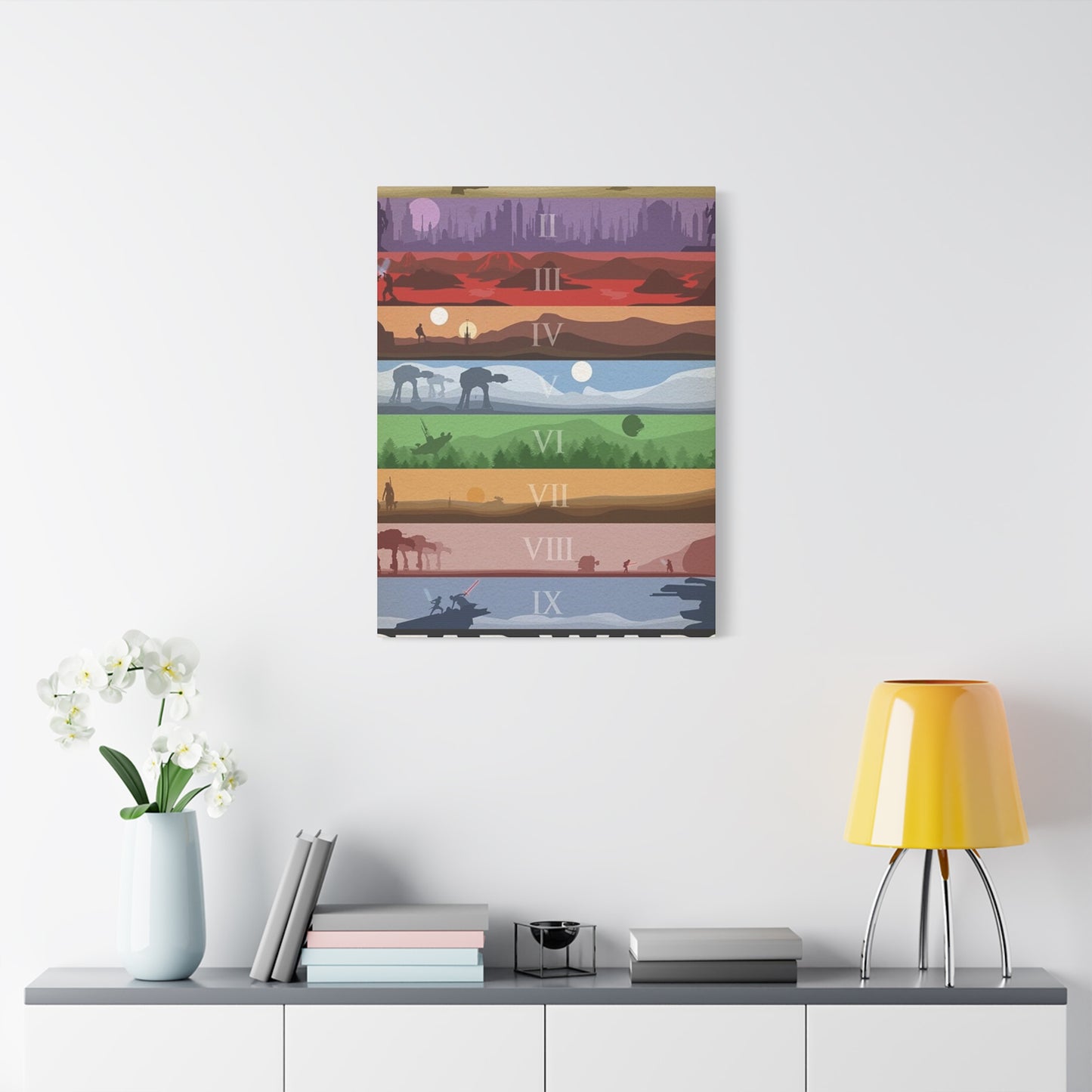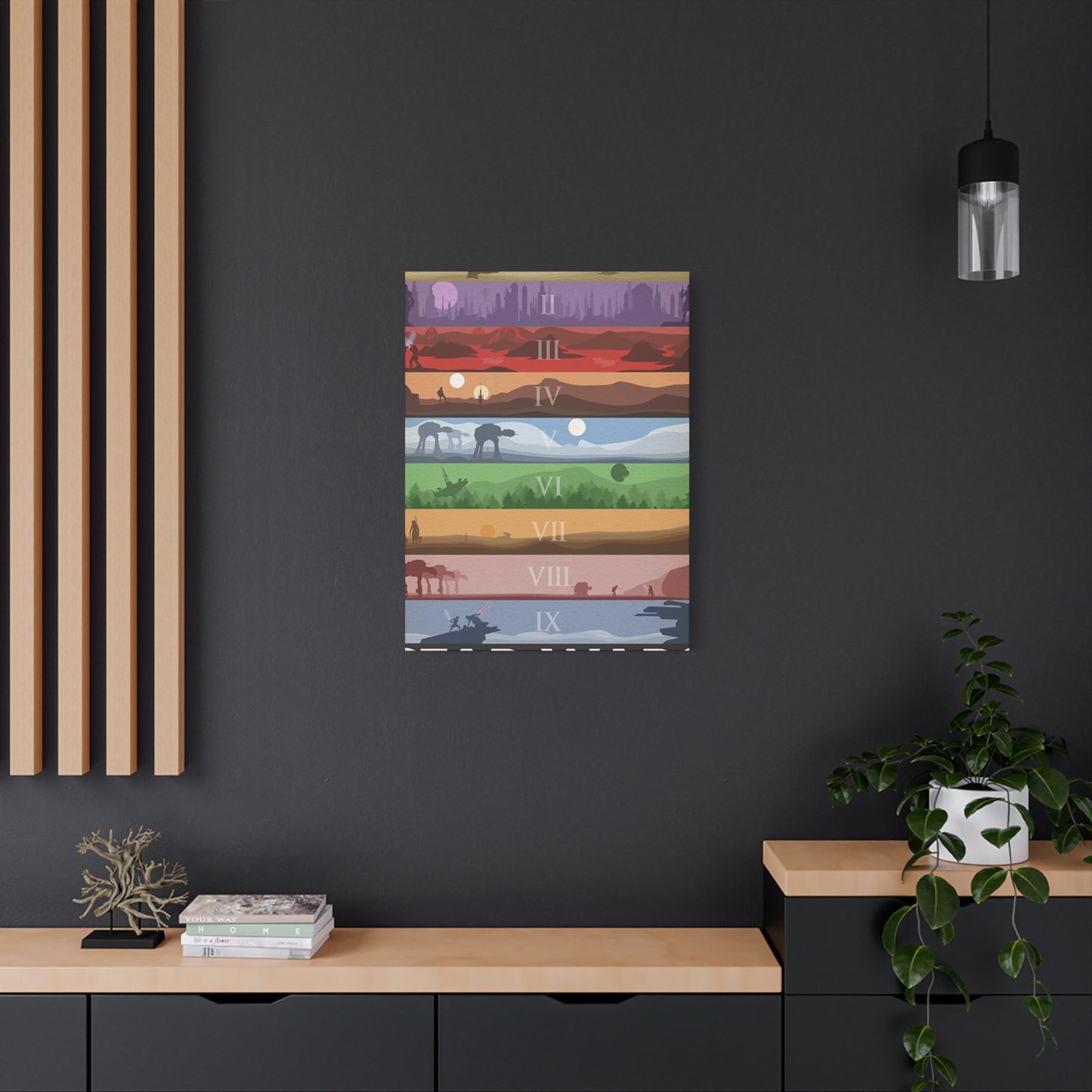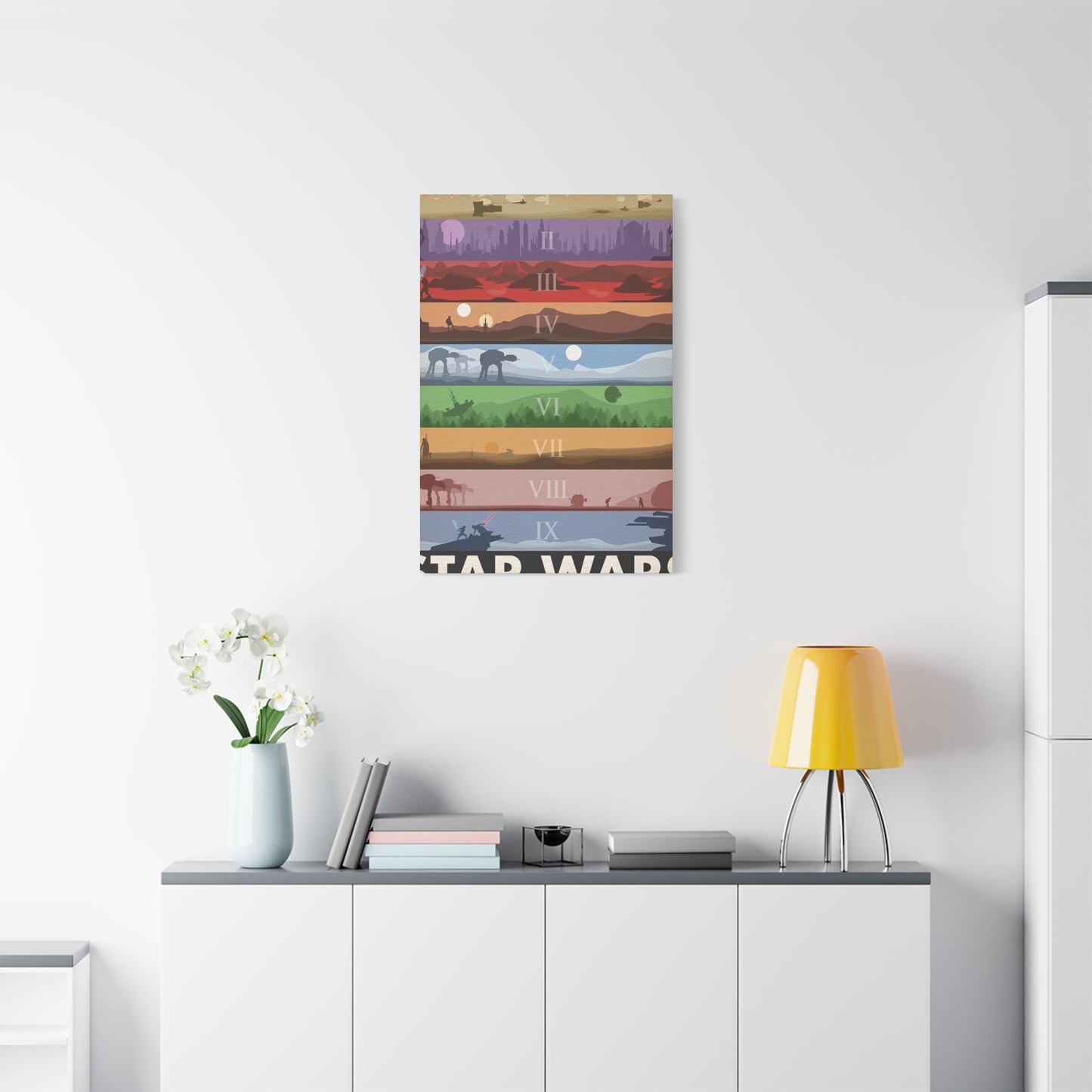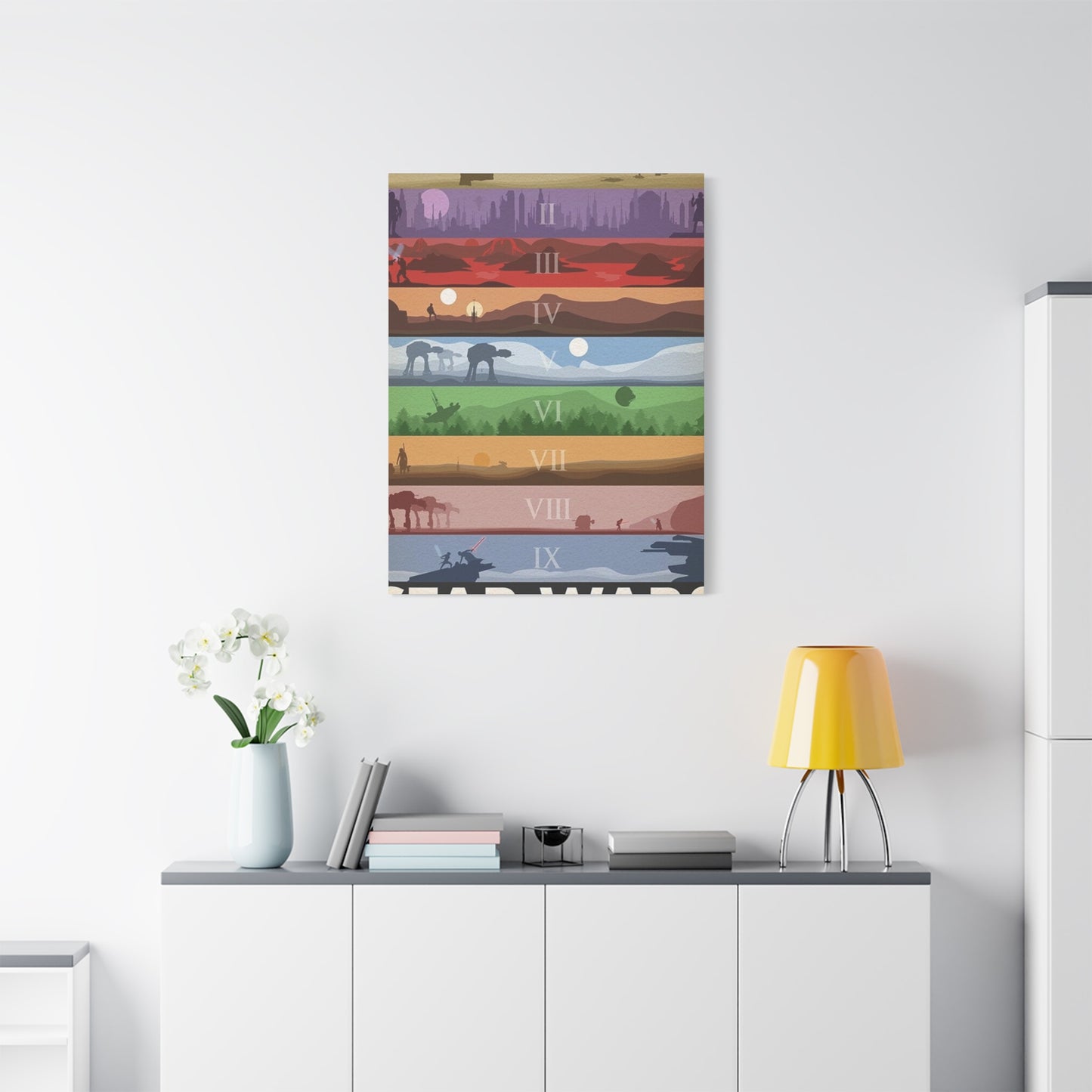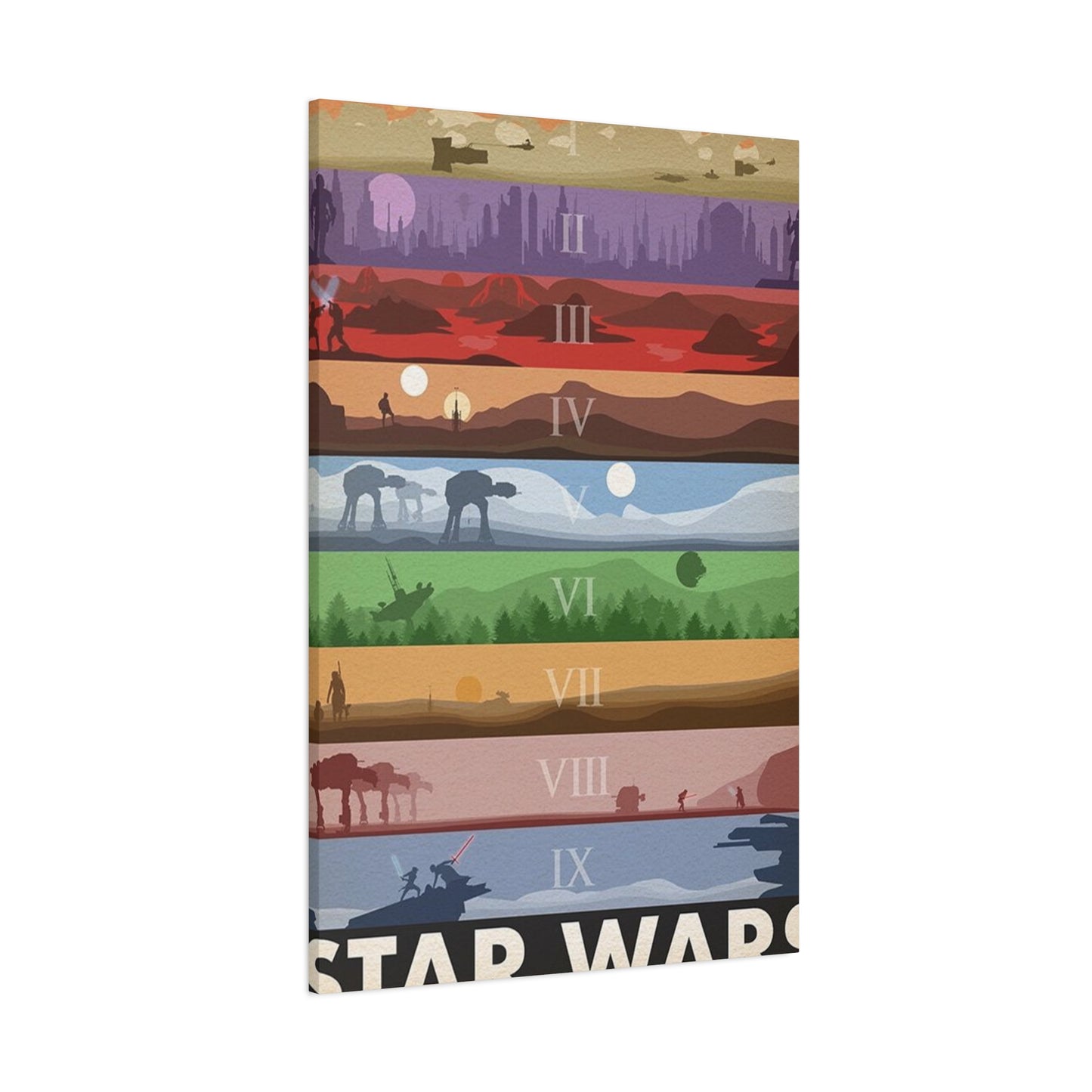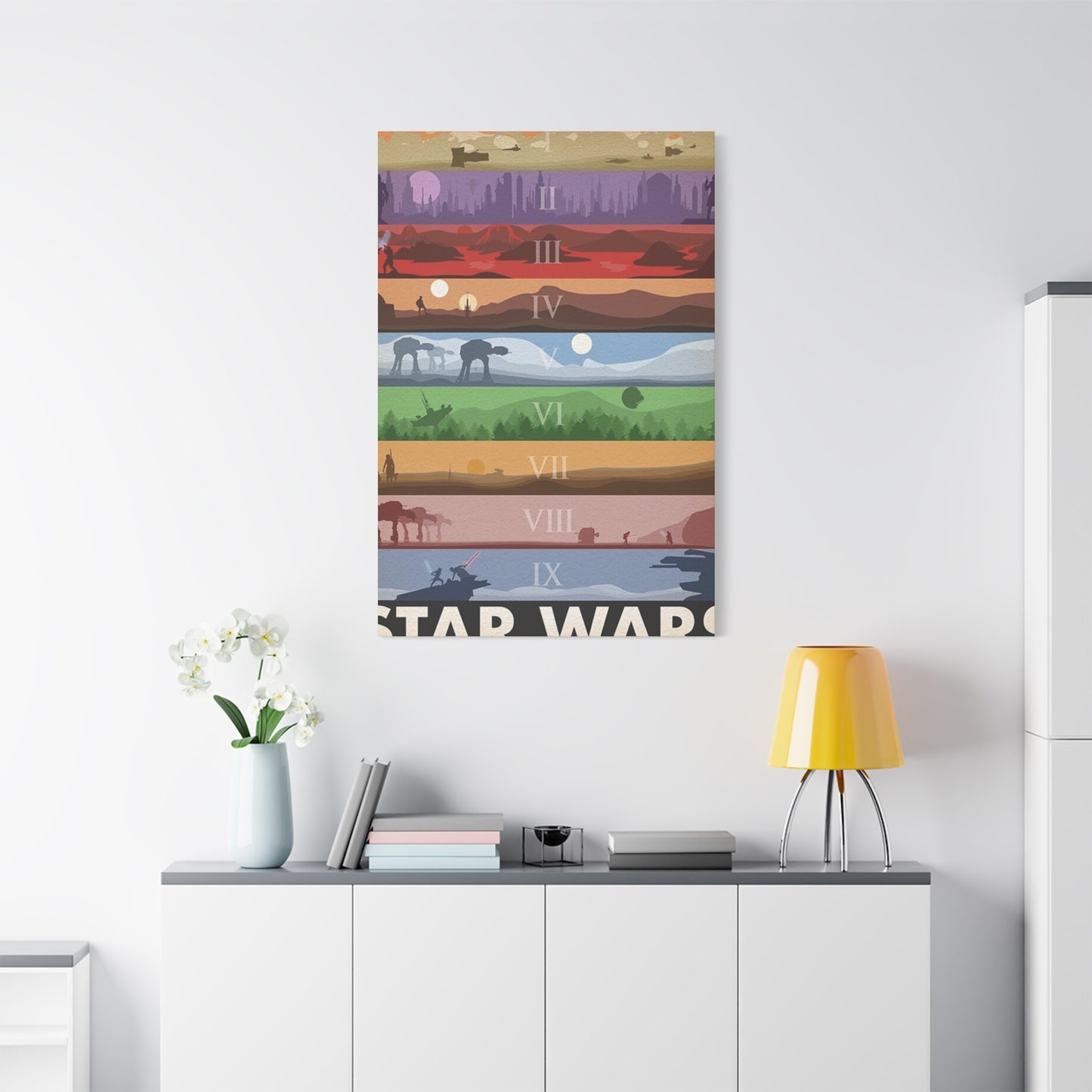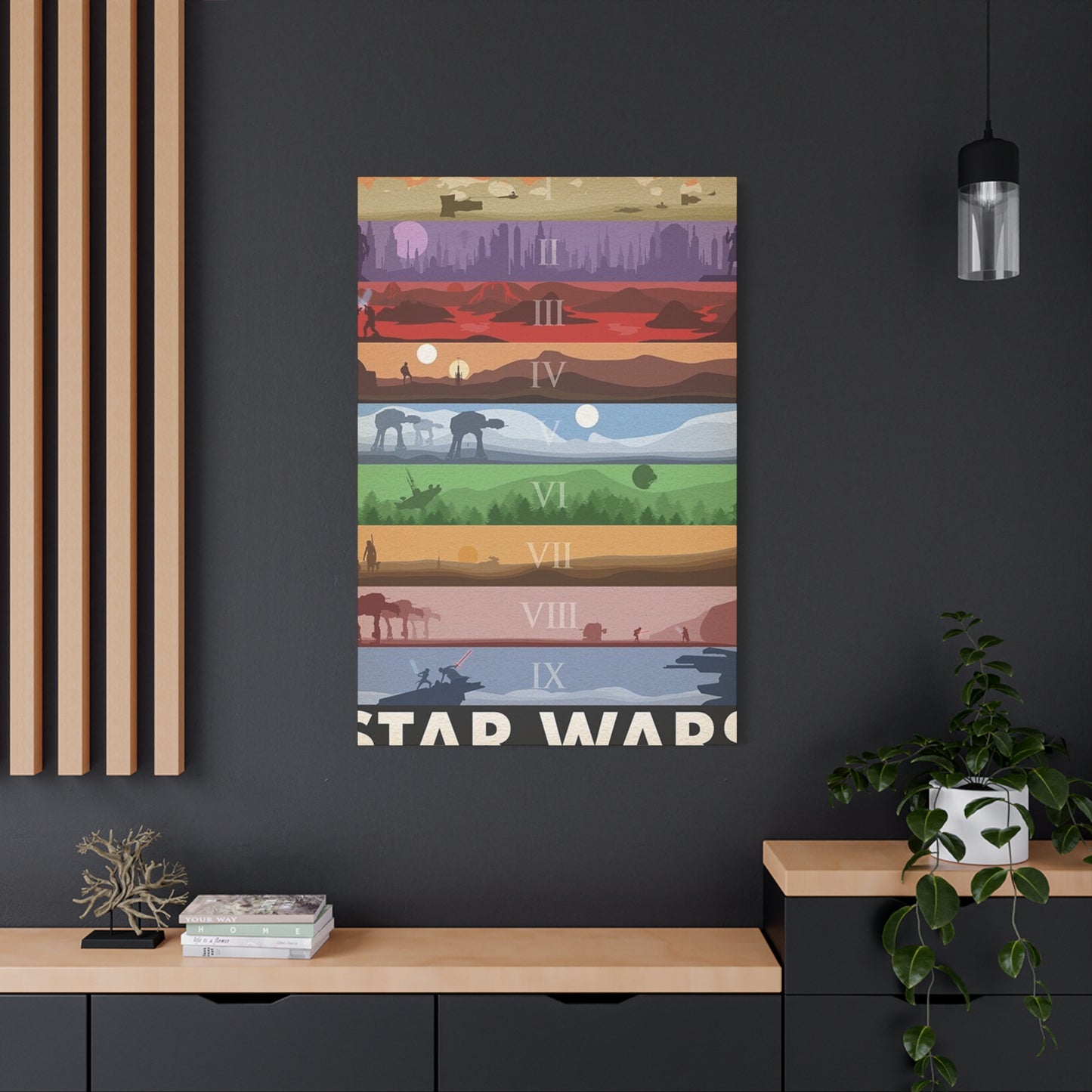Star Wars Sequels Wall Art: Transform Your Space with Galaxy-Inspired Décor
The galaxy far, far away has captured imaginations for decades, and the sequel trilogy brought fresh stories, characters, and visual spectacles that resonated with millions worldwide. Transforming living spaces with artwork inspired by these films has become increasingly popular among fans who want to showcase their passion for this beloved franchise. Wall décor featuring elements from the sequel trilogy offers an exciting way to personalize homes, offices, and entertainment areas while celebrating the continuation of this iconic saga.
The Rise of Galaxy-Inspired Home Décor
Home decoration has evolved significantly over recent years, moving beyond traditional paintings and generic prints. Enthusiasts now seek meaningful pieces that reflect their interests and personalities. The sequel trilogy introduced captivating visual elements, from stunning spacecraft designs to memorable character moments, providing abundant inspiration for creative wall displays. These decorative pieces serve multiple purposes, acting as conversation starters, mood enhancers, and expressions of personal identity within interior spaces.
Modern wall art inspired by the sequel films encompasses various styles, from minimalist designs to elaborate canvas prints that capture pivotal scenes. The diversity of available options means that fans can find pieces matching their aesthetic preferences while honoring their favorite moments from the trilogy. Whether someone prefers subtle nods to the franchise or bold statement pieces, the market offers countless possibilities for creating personalized spaces that reflect their connection to these stories.
The appeal of such décor extends beyond simple fandom. These pieces often feature exceptional artistry, combining color theory, composition, and design principles that make them valuable additions to any room regardless of theme. Professional artists and designers create works that balance franchise recognition with artistic merit, ensuring that wall displays remain visually appealing to both dedicated fans and casual observers.
Character-Focused Artwork Options
The sequel trilogy introduced memorable characters whose journeys resonated deeply with audiences. Artwork featuring these figures allows fans to celebrate their favorite personalities while adding dynamic visual interest to walls. From determined scavengers to conflicted warriors, the character roster provides rich material for artistic interpretation across multiple mediums and styles.
Rey's transformation throughout the trilogy offers particularly compelling subject matter for wall displays. Artists capture her evolution from desert scavenger to powerful force wielder through various compositions, color palettes, and artistic techniques. Some pieces emphasize her determination and strength through dramatic poses and lighting, while others focus on quieter moments of introspection that reveal her internal struggles and growth. The visual representation of her journey resonates with viewers who appreciate stories of self-discovery and empowerment.
Kylo Ren's complex character arc provides equally fascinating artistic opportunities. Wall art featuring this conflicted figure often explores themes of duality, redemption, and internal conflict through creative use of symbolism and visual metaphors. Dark and light contrasts, fractured imagery, and dramatic compositions help convey the turmoil that defines this character's path throughout the trilogy. Such pieces add depth and sophistication to interior spaces while honoring the nuanced storytelling that made this character memorable.
Supporting characters from the sequel films also receive artistic attention, with wall displays celebrating heroes like Finn, Poe, and Rose alongside memorable figures such as General Leia and Luke Skywalker in his later years. Each character brings unique visual possibilities, allowing collectors to build diverse galleries that represent the full scope of the trilogy's ensemble cast. Group compositions featuring multiple characters create dynamic focal points that capture the collaborative spirit essential to these stories.
Iconic Scene Recreations
Pivotal moments from the sequel trilogy translate beautifully into wall art, allowing fans to relive their favorite sequences daily. These scene recreations range from action-packed confrontations to emotionally charged exchanges, each capturing the essence of what made particular moments resonate with audiences. Professional artists employ various techniques to distill complex sequences into single, powerful images suitable for home display.
Battle scenes provide spectacular visual material for wall décor, with artistic interpretations capturing the energy and intensity of key conflicts. Spacecraft dogfights, lightsaber duels, and large-scale confrontations translate into dynamic compositions that add excitement and movement to interior spaces. Artists often employ techniques that convey motion and urgency, creating pieces that feel alive rather than static. Color choices, from vibrant reds and oranges suggesting combat to cooler blues and purples indicating tension, help establish mood and atmosphere.
Quieter, more introspective moments also inspire compelling artwork. Scenes emphasizing character development, emotional connections, or spiritual awakening offer opportunities for more subtle, contemplative pieces. These quieter compositions provide balance in home galleries, offering visual respite alongside more dramatic displays. They remind viewers that the sequel trilogy contained moments of genuine human connection and personal growth alongside spectacular action sequences.
Environmental scenes showcasing the trilogy's diverse locations create atmospheric wall art that transports viewers to different worlds. Desert landscapes, forest hideaways, oceanic vistas, and industrial complexes each offer distinct visual character. Artists capture the unique mood and feeling of these settings, allowing fans to bring small pieces of the galaxy into their homes. Such location-based artwork works particularly well in creating immersive themed spaces or adding exotic visual interest to conventional rooms.
Minimalist Design Approaches
Not all fans prefer elaborate, detailed artwork. Minimalist designs inspired by the sequel trilogy offer sophisticated alternatives that incorporate franchise elements while maintaining clean, modern aesthetics. These simplified approaches use essential visual information to evoke recognition without overwhelming spaces, making them ideal for contemporary interiors or professional environments where subtlety is preferred.
Line art representations of characters, vehicles, and symbols distill complex subjects into their fundamental forms. Single-line drawings or geometric simplifications create elegant pieces that appeal to design-conscious fans who appreciate understated references. These minimalist works often employ negative space effectively, allowing the absence of detail to become as important as the lines themselves. The result is artwork that rewards close examination while remaining visually calm from a distance.
Color-blocked designs take key visual elements and reduce them to simplified color zones, creating bold, graphic pieces with immediate visual impact. These designs might represent characters through signature costume colors or depict spacecraft through flat, angular shapes. The simplification process highlights essential characteristics while removing unnecessary complexity, resulting in contemporary pieces that work well in modern interiors.
Typographic approaches incorporate meaningful quotes, character names, or thematic words into visually interesting compositions. These text-based designs range from straightforward presentations to creative arrangements where words form shapes or images. Typography fans appreciate how these pieces combine literary and visual appeal, making them particularly suitable for home offices, libraries, or reading nooks where words carry special significance.
Symbol and iconography-focused minimalist art celebrates the visual language developed throughout the franchise. Simplified representations of organizational emblems, weapon silhouettes, or technological elements create instantly recognizable pieces that communicate franchise connection without requiring detailed imagery. These works often function equally well as standalone pieces or as parts of larger gallery wall arrangements.
Canvas Print Collections
Canvas prints offer accessible, affordable options for fans wanting to decorate larger wall spaces. The sequel trilogy provides abundant material for canvas collections, with sets designed to work together creating cohesive visual statements. Multiple-panel arrangements, known as diptychs, triptychs, or polyptychs depending on piece count, allow for creative compositions that tell visual stories across connected canvases.
Character triptychs featuring three related figures create balanced arrangements that celebrate ensemble casts. These multi-panel sets might show character progression across the trilogy, represent different aspects of a single character's journey, or bring together three complementary personalities. The separated-yet-connected nature of multiple canvas arrangements adds dimensional interest to flat walls while providing flexibility in arrangement and spacing.
Scene-based canvas collections break pivotal moments across multiple panels, creating panoramic effects that immerse viewers in specific sequences. A climactic confrontation might span three or five panels, with action flowing seamlessly from one canvas to the next. This approach creates dramatic focal points suitable for large walls in living rooms, entertainment spaces, or home theaters where impact matters.
Abstract interpretations transform recognizable elements into artistic compositions emphasizing color, texture, and form over literal representation. These canvas prints appeal to fans seeking artwork that suggests franchise connections without explicit imagery. Swirling colors might evoke space battles, geometric patterns could reference technological elements, or textural contrasts might represent thematic dualities. Such pieces integrate more easily into diverse interior design schemes while maintaining meaningful connections for informed viewers.
Size variations within canvas collections allow for creative arrangements beyond simple linear displays. Mixing larger central pieces with smaller supporting canvases creates visual hierarchy and interest. Staggered arrangements, asymmetrical groupings, and layered depths transform blank walls into dynamic installations that command attention while maintaining artistic cohesion.
Metal and Aluminum Print Advantages
Metal prints offer distinctive alternatives to traditional canvas or paper options, bringing unique visual properties that enhance sequel trilogy artwork. The printing process bonds inks directly to aluminum surfaces, creating vibrant, luminous images with exceptional clarity and depth. These characteristics make metal prints particularly effective for displaying spacecraft, technological elements, and high-contrast scenes where visual punch matters.
The inherent qualities of metal surfaces contribute to artwork's overall impact. Natural metallic sheen adds dimension and interest, particularly to pieces featuring spacecraft, weapons, or mechanical elements where metallic properties feel thematically appropriate. Light interacts differently with metal prints compared to other mediums, creating subtle variations in appearance as viewing angles change throughout the day. This dynamic quality keeps artwork feeling fresh rather than static.
Durability represents another significant advantage of metal prints. The printing process creates water-resistant, scratch-resistant surfaces suitable for various environments including bathrooms, kitchens, or high-traffic areas where traditional prints might suffer damage. This resilience makes metal prints practical choices for active households, commercial spaces, or any location where artwork faces potential wear.
The frameless presentation typical of metal prints contributes to contemporary, streamlined aesthetics. Floating mount systems create separation between wall and artwork, adding dimensional interest while maintaining clean lines. This mounting approach works particularly well in modern interiors where minimalism and simplicity are valued design principles.
Color vibrancy on metal prints exceeds what most other mediums can achieve, with deep blacks, bright highlights, and saturated midtones creating punchy, eye-catching displays. Space scenes with star fields, nebulas, and light effects look particularly spectacular on metal, with luminosity that traditional prints struggle to match. Action sequences featuring lightsaber combat or weapon fire gain additional energy through the enhanced color saturation metal printing provides.
Framed Poster Presentation
Traditional framed posters remain popular options for displaying sequel trilogy artwork, offering classic presentation styles that work in virtually any setting. The combination of quality prints and complementary frames creates polished, professional displays suitable for both personal and commercial spaces. Frame selection significantly impacts overall presentation, with countless options available to match various décor styles and personal preferences.
Wood frames bring warmth and traditional appeal to sequel trilogy posters, with grain patterns and natural tones creating organic counterpoints to technological subject matter. Different wood species, stains, and finishes allow for extensive customization, ensuring frames complement both artwork and surrounding décor. Distressed or weathered wood frames can add vintage character, particularly effective for pieces emphasizing the lived-in, used-future aesthetic that defines the franchise's visual approach.
Metal frames offer sleek, modern alternatives that emphasize contemporary aesthetics. Black metal frames create bold, graphic presentations that focus attention on artwork itself, while silver or gold metallic options add elegance and sophistication. The clean lines and minimal profiles of metal frames work particularly well with minimalist or geometric artwork where visual simplicity is paramount.
Floating frames, which suspend prints between two pieces of glass or acrylic, create striking three-dimensional presentations. This approach adds literal depth while protecting artwork from both sides. The floating effect draws attention to pieces, making them appear gallery-quality regardless of subject matter. Such presentation works exceptionally well for limited edition prints or particularly meaningful pieces deserving special treatment.
Mat board selection within framed presentations provides additional customization opportunities. White or cream mats create classic, clean presentations suitable for any artwork style, while colored mats can complement or contrast with dominant tones in prints themselves. Double matting, using two different colored mats layered together, adds additional sophistication and visual interest to framed displays.
Gallery Wall Arrangements
Creating gallery walls dedicated to sequel trilogy artwork allows fans to display multiple pieces together, building comprehensive visual narratives that celebrate various aspects of the films. These multi-piece arrangements transform blank walls into personal museums that reflect individual connections to characters, stories, and themes. Successful gallery walls balance variety with cohesion, mixing different sizes, styles, and subjects while maintaining overall harmony.
Grid arrangements bring order and structure to gallery walls, with uniform spacing and alignment creating clean, modern presentations. This approach works particularly well when mixing multiple similar-sized pieces, creating visual rhythm through repetition. Grid layouts feel intentional and designed, communicating that artwork has been thoughtfully curated rather than randomly assembled.
Salon-style arrangements embrace organized chaos, mixing various sizes and orientations without rigid grid structures. These more organic layouts feel collected over time, suggesting personal journeys rather than one-time purchases. Salon walls work well for fans with diverse tastes, allowing minimalist prints to coexist with detailed scenes, character portraits to share space with abstract pieces, and vintage-style posters to complement modern designs.
Symmetrical arrangements create balanced, harmonious displays by mirroring elements across central axes. A large centerpiece flanked by smaller complementary pieces establishes clear focal points while maintaining equilibrium. This approach feels stable and considered, working well in formal spaces or anywhere visual balance is desired.
Asymmetrical arrangements embrace intentional imbalance, using varied sizes and placements to create dynamic, energetic displays. These layouts guide eyes through deliberate visual journeys, with larger pieces anchoring arrangements while smaller elements provide supporting interest. Asymmetry can make gallery walls feel more personal and less rigid, reflecting the spontaneity and personality of those who created them.
Thematic groupings organize pieces around specific ideas, characters, or visual concepts. A gallery wall might focus exclusively on a single character's journey, showcase only vehicle and spacecraft artwork, or present various artistic interpretations of key symbols. Thematic consistency creates strong visual statements while allowing variety within chosen parameters.
Digital and LED-Enhanced Options
Technology integration brings new dimensions to sequel trilogy wall art, with digital and LED-enhanced options offering dynamic alternatives to static prints. These innovative approaches leverage modern capabilities to create displays that change, illuminate, or respond to environments in ways traditional artwork cannot match.
LED backlighting transforms standard prints into glowing displays that create ambient lighting while showcasing artwork. Light panels behind posters or canvas prints add luminosity that makes images appear to emit their own light, particularly effective for space scenes, lightsaber imagery, or any subject involving illumination. Adjustable brightness allows these pieces to function as both art and practical lighting sources, creating atmosphere while serving functional purposes.
Digital frames displaying rotating artwork collections allow fans to showcase extensive libraries without dedicating entire rooms to physical pieces. High-resolution displays cycle through images at set intervals, ensuring fresh visuals regularly. This approach particularly appeals to collectors who cannot decide on single favorite pieces or those wanting variety without constant physical rearrangement.
Projection mapping technology enables elaborate displays that transform entire walls into immersive environments. Specialized projectors display animated sequences, creating living artwork that brings scenes to life. While more complex and expensive than traditional options, projection displays create spectacular effects for dedicated home theaters or entertainment spaces where immersion is paramount.
Interactive displays respond to motion, touch, or voice commands, creating engaging experiences beyond passive viewing. These technological artworks might reveal hidden details upon interaction, change based on time of day, or display different content in response to viewer preferences. While representing the cutting edge of home décor technology, interactive displays hint at future possibilities for franchise-inspired wall art.
Vintage and Retro Styling
Nostalgia influences much modern design, and sequel trilogy artwork embracing vintage aesthetics appeals to fans appreciating retro visual approaches. These pieces reimagine contemporary films through historical design lenses, creating interesting tensions between old and new that result in distinctive, character-filled displays.
Distressed printing techniques artificially age artwork, adding faux wear that suggests pieces have existed for decades. Faded colors, deliberately damaged edges, and texture overlays mimicking aged paper create vintage character. These treatments work particularly well for poster-style designs, making new artwork feel like discovered treasures from imaginary pasts.
Retro color palettes employing muted, desaturated tones or limited color ranges evoke different eras of printing and design. Sepia tones suggest early photography, limited color screens recall mid-century posters, and faded primaries evoke sun-bleached prints from decades past. These color choices create specific moods while differentiating artwork from typical contemporary approaches.
Typography and graphic design elements borrowing from historical periods create fascinating mashups. Art deco borders, Victorian flourishes, or mid-century modern geometric patterns combined with sequel imagery produce unique pieces that exist outside normal stylistic categories. These anachronistic designs appeal to fans appreciating creative reinterpretations over straightforward representations.
Propaganda poster styling applies historical political and motivational poster aesthetics to sequel trilogy factions and conflicts. Bold graphics, simplified color schemes, and commanding typography transform narrative elements into striking visual statements. These pieces work particularly well for fans interested in the political dimensions of the stories or those appreciating graphic design history.
Abstract and Artistic Interpretations
Not all sequel trilogy wall art needs obvious franchise connections. Abstract and artistic interpretations translate themes, colors, and concepts into pieces that function as sophisticated décor while maintaining meaningful connections for informed viewers. These approaches allow fans to incorporate franchise elements into spaces where explicit imagery might feel inappropriate or overly themed.
Color field paintings inspired by signature palettes from key scenes create atmospheric pieces that evoke without depicting. The reds and oranges of a specific planet might inspire warm, energetic abstracts, while cool blues and grays from another location could inform calm, contemplative pieces. These color-driven works trigger memories and associations for fans while appearing as general abstract art to uninformed viewers.
Texture-based compositions explore tactile qualities suggested by various environments and elements. Rough, weathered surfaces might reference desert planets, smooth metallic textures could evoke technological aspects, or organic patterns might represent natural locations. These pieces add dimensional interest to walls while connecting to franchise elements through physical rather than visual representation.
Geometric abstractions reduce complex subjects to fundamental shapes and patterns. Circular forms might reference planetary bodies or technological interfaces, angular compositions could suggest spacecraft or architectural elements, and flowing curves might represent energy or movement. The simplification process creates visually interesting pieces that reward interpretation while maintaining stylistic flexibility.
Mixed media approaches combine various materials, techniques, and elements into complex compositions that blur lines between painting, sculpture, and collage. Layered papers, embedded objects, applied textures, and varied painting techniques create rich, dimensional pieces with depth and presence. These sophisticated artworks elevate sequel trilogy inspiration into fine art territory, suitable for serious collectors and art enthusiasts.
Customization and Personalization
Personalized wall art allows fans to create truly unique pieces incorporating individual preferences, names, or specific combinations of elements. Custom options range from simple text additions to completely original compositions designed around personal specifications. This level of customization ensures artwork perfectly matches both franchise passion and individual taste.
Name incorporation transforms standard designs into personalized displays. Character names, favorite quotes, or personal names styled in franchise-appropriate typography create meaningful connections between viewers and artwork. These customized pieces make excellent gifts, particularly for children or young fans establishing their own spaces.
Custom color schemes allow existing designs to be reinterpreted in preferred palettes, ensuring artwork coordinates with specific interior design plans. A design typically rendered in cool tones might be transformed using warm colors to match particular rooms, or signature colors from other interests might be incorporated to create unique mashups reflecting multiple passions.
Combination pieces bringing together elements from different sources create entirely new compositions. Fans might request artwork merging favorite characters from various trilogy chapters, combining spacecraft from different factions, or mixing symbolic elements in personally meaningful arrangements. These custom creations result in one-of-a-kind pieces impossible to find in standard collections.
Photography integration allows personal photos to be combined with sequel trilogy elements, creating unique commemorative pieces. Vacation photos from filming locations might be enhanced with subtle franchise graphics, convention photographs could be styled as in-universe documents, or family photos might be framed with themed borders and elements. These personalized mashups celebrate both franchise passion and personal memories.
Size Considerations and Scale
Selecting appropriately sized artwork for available wall space significantly impacts overall presentation effectiveness. Understanding scale relationships helps ensure pieces feel proportional and intentional rather than awkwardly small or overwhelmingly large for their locations.
Small prints measuring twelve by sixteen inches or less work well for intimate spaces, desk areas, or as parts of larger gallery wall arrangements. These modest pieces suit bedrooms, offices, bathrooms, or any location where subtle franchise nods are preferred over bold statements. Multiple small pieces grouped together can create substantial visual impact while maintaining individual delicacy.
Medium-sized pieces ranging from sixteen by twenty to twenty-four by thirty-six inches serve as versatile options suitable for various applications. These dimensions work well as solo focal points in smaller rooms or as significant elements within larger gallery walls. Medium prints balance visibility with flexibility, large enough to appreciate detail without overwhelming spaces.
Large-format pieces exceeding thirty-six inches in any dimension make bold statements demanding attention. These substantial artworks work best as standalone focal points in spacious rooms where they have breathing room. Large pieces above sofas, beds, or entertainment centers establish strong visual anchors that organize surrounding décor.
Oversized and mural-scale options transform entire walls into immersive displays. Pieces spanning six, eight, or more feet across create room-defining installations that completely alter space perception. These dramatic displays suit dedicated home theaters, game rooms, or any location where immersive theming is desired. Installation of such large pieces often requires professional help but results in spectacular effects impossible to achieve with smaller options.
Proportion guidelines suggest artwork spanning roughly two-thirds to three-quarters the width of furniture pieces above which they hang. This ratio creates pleasing visual relationships between elements while ensuring neither furniture nor artwork overwhelms the other. Adjusting based on specific circumstances and personal preferences remains appropriate, but this guideline provides useful starting points for planning arrangements.
Material Quality and Longevity
Investment in quality materials ensures sequel trilogy wall art remains vibrant and intact for years or decades. Understanding different production methods, substrates, and protective treatments helps fans make informed decisions balancing immediate costs with long-term value.
Archival-quality printing uses acid-free papers and lightfast inks resistant to fading and degradation. These museum-grade materials maintain color accuracy and structural integrity far longer than standard printing supplies. While more expensive initially, archival prints protect investments by ensuring artwork looks fresh for generations rather than deteriorating within years.
Giclée printing represents premium inkjet technology using high-resolution imaging and specialized inks for exceptional quality. The term originally applied only to iris prints but has broadened to encompass various professional digital printing methods. True giclée prints use archival materials and produce gallery-worthy results suitable for serious collections.
Canvas quality varies significantly across products, with tightly woven, substantial fabrics providing better results than loosely woven, thin alternatives. Gallery-wrapped canvases, where fabric wraps around frame edges, offer more polished presentations than simple stretched canvases. Coating applications protect canvas prints from moisture and UV damage while enhancing color saturation.
Paper weight and finish affect both appearance and durability. Heavier stocks feel more substantial and resist damage better than thin papers. Matte finishes minimize glare and provide sophisticated appearances, while gloss finishes enhance color vibrancy and create dramatic effects. Satin finishes split the difference, offering moderate sheen without excessive reflection.
Protective treatments including UV-resistant glass or acrylic, lamination, or clear coat applications shield artwork from environmental damage. These barriers prevent fading from sunlight exposure, resist moisture damage, and make cleaning easier. While adding cost, protective treatments dramatically extend artwork lifespans, particularly for pieces displayed in challenging locations.
Color Psychology and Room Impact
Color choices in sequel trilogy wall art significantly influence room atmospheres and emotional responses. Understanding color psychology helps fans select pieces creating desired moods while complementing existing décor schemes.
Warm colors including reds, oranges, and yellows generate energy, excitement, and warmth. Artwork dominated by these tones adds vibrancy to spaces, making rooms feel more alive and dynamic. Warm-toned pieces work well in social areas like living rooms or dining spaces where energetic atmospheres are desired. However, excessive warm colors in bedrooms might prove overstimulating for restful environments.
Cool colors including blues, purples, and greens create calm, relaxing atmospheres promoting tranquility and focus. These tones work excellently in bedrooms, home offices, or meditation spaces where peace and concentration matter. Cool-toned sequel trilogy artwork featuring space scenes, certain character portraits, or environmental landscapes can establish serene visual foundations for various rooms.
Neutral colors including blacks, whites, grays, and earth tones provide versatility and sophistication. Neutrally colored artwork integrates easily with diverse décor styles while maintaining visual interest through composition and subject rather than color intensity. These pieces work virtually anywhere, making them safe choices for commitment-wary decorators or those anticipating future design changes.
Contrasting colors create visual excitement and draw attention through opposing positions on color wheels. Artwork incorporating strong contrasts between complementary colors generates energy and impact, immediately catching eyes. This approach works well for statement pieces intended as room focal points.
Analogous colors, sitting adjacent on color wheels, create harmonious, cohesive appearances. Artwork using related color families feels coordinated and intentional without the visual shock of extreme contrasts. These pieces integrate smoothly into rooms, enhancing without overwhelming existing color schemes.
Placement Strategies Throughout Homes
Strategic artwork placement maximizes visual impact while respecting practical considerations. Different rooms and spaces suggest different approaches to displaying sequel trilogy wall art effectively.
Living rooms, serving as primary gathering and entertainment spaces, accommodate larger statement pieces or comprehensive gallery walls. Above sofas or entertainment centers represents prime real estate for substantial artworks establishing room focal points. Multiple smaller pieces grouped on adjacent walls create visual interest without competing with central displays.
Bedrooms benefit from calmer, more personal artwork selections. Pieces above beds serve as last sights before sleep and first views upon waking, making theme and color particularly important. Bedroom art should reflect personal connections rather than impressing guests, allowing for more intimate or experimental choices. Smaller pieces on dresser walls or in reading nooks add layers of interest without overwhelming restful atmospheres.
Home offices require artwork supporting productivity and creativity without creating distraction. Pieces within natural sight lines when working can provide inspiration and brief mental breaks, while artwork behind work positions remains visible during video calls, subtly communicating interests and personality. Motivational themes or character-focused pieces can reinforce positive mental states during work hours.
Hallways and staircases offer opportunities for linear gallery arrangements, with multiple pieces creating visual journeys along paths of movement. Ascending or descending staircases allow for creative progressions telling visual stories or representing character journeys. Narrow hallway walls accommodate vertical arrangements that draw eyes upward, making spaces feel taller.
Bathrooms, often neglected in décor planning, can incorporate smaller sequel trilogy pieces adding personality to utilitarian spaces. Water-resistant options including metal prints or properly sealed canvases withstand humid conditions while transforming bathrooms into more interesting environments.
Kitchen spaces might seem unlikely locations for franchise artwork, but carefully selected pieces can add character without interfering with practical functions. Smaller prints in breakfast nooks, dining areas, or above countertops unsuitable for cabinets create unexpected delights. Ensure any kitchen artwork is protected from cooking-related hazards including grease and moisture.
Entertainment and game rooms embrace more elaborate theming without restraint, serving as ideal locations for extensive gallery walls, large-format pieces, or technologically enhanced displays. These dedicated hobby spaces allow full immersion in franchise aesthetics without needing to balance other design considerations.
Children's rooms accommodate age-appropriate sequel trilogy artwork helping young fans personalize their spaces. Colorful, character-focused pieces appeal to younger children, while more sophisticated designs suit teenagers. Allowing children input in selection creates ownership and investment in their environments while teaching decision-making about personal spaces.
Lighting Techniques for Art Display
Proper lighting dramatically enhances artwork appearance while protecting pieces from damage. Understanding various lighting approaches helps fans showcase sequel trilogy wall art optimally.
Natural lighting provides full-spectrum illumination that accurately renders colors but risks UV damage over time. Positioning artwork to receive indirect natural light offers benefits without excessive exposure. Sheer window treatments can diffuse harsh direct sunlight, protecting artwork while maintaining natural illumination. Rotating particularly light-sensitive pieces away from windows extends their lifespans.
Picture lights mounted directly on frames or walls above artwork provide dedicated illumination highlighting specific pieces. LED picture lights offer energy efficiency and minimal heat output, reducing damage risks. Adjustable fixtures allow precise positioning to eliminate glare while ensuring even coverage across entire pieces.
Track lighting systems offer flexibility for gallery walls or multiple pieces, with adjustable heads directing light exactly where needed. This approach works particularly well in rooms with multiple artworks requiring individual attention. Dimmer integration allows atmosphere adjustments based on time of day or activity.
Recessed ceiling lights, when properly positioned, provide ambient illumination that washes walls evenly. Directional recessed fixtures can angle light toward specific artworks, creating subtle highlighting within overall ambient schemes. This architectural approach maintains clean ceiling lines while serving functional and aesthetic purposes.
Accent lighting using wall sconces flanking artwork creates balanced illumination while adding decorative elements complementing displays. Coordinating sconce styles with room décor ensures cohesive presentations where lighting and artwork work together rather than competing for attention.
Avoiding common lighting mistakes protects artwork and presentation quality. Lights positioned to create glare on glazed or glass-covered pieces frustrate viewing, so angles require careful consideration. Excessive heat from inappropriate bulbs damages artwork over time, making cool-running LEDs preferable. Overlighting washes out colors and details, while underlighting renders artwork invisible, requiring balance.
Budget-Friendly Acquisition Methods
Building sequel trilogy wall art collections need not require substantial financial investment. Various strategies allow fans to acquire quality pieces while respecting budget constraints.
Print-on-demand services offer affordable options by eliminating inventory costs and middlemen. These platforms allow fans to order prints only when desired, in specific sizes matching exact needs. While sacrificing some quality compared to premium options, reputable print-on-demand services provide acceptable results at fraction of costs.
Sales and clearance events provide opportunities for discounted pieces. Following favorite artists or shops and joining mailing lists ensures awareness of promotional periods. End-of-season sales, holiday promotions, and clearance of discontinued designs offer significant savings for patient collectors willing to wait for deals.
Digital downloads represent extremely economical options for artwork acquisition. Purchasing digital files allows home printing through local services, often at lower total costs than buying finished pieces. This approach also enables size customization and reprinting if pieces become damaged, providing long-term value beyond initial purchases.
DIY projects allow creative fans to produce original artwork reflecting personal visions. Painting, drawing, or crafting sequel trilogy-inspired pieces provides creative satisfaction while generating truly unique décor. Abundant tutorials and inspiration sources support those developing artistic skills, making this approach accessible regardless of current ability levels.
Print shops and office supply stores often provide professional printing services at competitive rates. Bringing high-quality digital files to these locations for printing on quality paper or cardstock produces satisfactory results for budget-conscious fans. Pairing these prints with affordable frames from discount retailers creates polished presentations at minimal costs.
Trading and community exchanges within fan groups allow collectors to diversify without spending. Online communities frequently organize swaps where participants trade pieces, or local groups might arrange in-person exchanges. These interactions build connections while refreshing collections through circulation rather than purchase.
Supporting Independent Artists
The sequel trilogy has inspired countless independent artists creating original interpretations and designs. Supporting these creators provides unique artwork while sustaining artistic communities and individuals pursuing creative passions.
Discovering independent artists through social platforms, online marketplaces, and fan communities opens worlds of possibilities beyond mass-produced options. These creators often offer pieces unavailable elsewhere, with distinctive styles setting their work apart from commercial alternatives. Following artists directly provides insight into creative processes while ensuring awareness of new releases.
Limited edition prints from independent artists offer collectibility and exclusivity. These numbered releases guarantee piece rarity, potentially increasing value over time while ensuring owned artwork remains distinctive rather than ubiquitous. Limited runs also support artists more directly than mass-produced alternatives, with higher percentages of sales reaching creators themselves.
Commission opportunities allow fans to request specific subjects, compositions, or styles directly from artists. While typically more expensive than purchasing existing works, commissions produce exactly desired results tailored to individual preferences. This collaboration between fan and artist creates meaningful connections and artwork with special personal significance.
Artist signatures and certificates of authenticity add value and legitimacy to independent artwork. These elements distinguish genuine pieces from reproductions while providing documentation for collections. Some collectors specifically seek signed pieces, appreciating direct connections to creating artists.
Fair compensation ensures artists can continue creating, so balancing budget consciousness with appropriate pricing supports sustainable creative economies. While seeking deals remains reasonable, extremely low prices often indicate either questionable legality or unsustainable business practices. Paying fair rates for quality work benefits everyone involved in artistic ecosystems.
Legal and Copyright Considerations
Understanding intellectual property issues helps fans navigate artwork acquisition ethically and legally. The sequel trilogy, like all major franchise properties, involves complex copyright situations requiring awareness and respect.
Official licensed merchandise carries appropriate permissions from rights holders, ensuring purchases support legitimate operations and creators. Licensed products display authorization marks or logos, providing confidence that transactions respect intellectual property law. While often more expensive than alternatives, licensed items guarantee legal compliance.
Fan art occupies complicated legal territory, with transformative works potentially qualifying for fair use protections while potentially infringing copyrights. Many rights holders tolerate fan art recognizing its promotional value and community importance, but tolerance does not equal explicit permission. Fans purchasing unofficial artwork should understand potential legal ambiguities, though enforcement against individual purchasers remains rare.
Counterfeit products illegally reproduce official designs without authorization, denying rights holders and legitimate creators rightful compensation. Identifying counterfeits requires attention to quality, pricing, seller reputation, and authorization marks. Avoiding counterfeit purchases protects personal interests while respecting intellectual property rights.
Personal use versus commercial use distinctions matter significantly in copyright contexts. Creating sequel trilogy artwork for personal home display generally receives less scrutiny than commercial sales or public exhibitions. This distinction explains why many artists sell fan art despite technical copyright concerns, the personal nature and limited scale of transactions falling outside aggressive enforcement.
Supporting legitimate channels, whether through official merchandise or authorized independent creators, ensures continued content creation and artistic freedom. Rights holders more readily accept fan expressions when feeling commercial interests remain protected, making support of legitimate options beneficial for entire communities.
Display Cases and Protection
Valuable or particularly meaningful sequel trilogy artwork deserves protection beyond simple hanging. Display cases, frame upgrades, and protective measures ensure pieces remain pristine while remaining visible.
Shadow boxes create three-dimensional displays protecting artwork while adding depth. These deeper frames accommodate objects, memorabilia, or dimensional elements alongside prints, creating mixed-media presentations. Shadow boxes work particularly well for combining artwork with related collectibles, building cohesive displays that tell richer stories.
Acrylic display cases offer clear protection while maintaining full visibility. These enclosures shield artwork from dust, moisture, and physical contact without obscuring views. Museum-quality acrylic provides UV filtering while remaining clearer than glass, making it ideal for valuable pieces requiring maximum protection.
Anti-reflective glass reduces glare that interferes with viewing, particularly important for locations with challenging lighting conditions. This specialty glazing allows comfortable viewing from various angles without reflections obscuring artwork. While more expensive than standard glass, anti-reflective options significantly improve display quality in problematic locations.
Climate control considerations protect artwork in environments with temperature or humidity fluctuations. Avoiding placement near heating vents, air conditioning returns, or sources of moisture preserves pieces by maintaining stable conditions. Dehumidifiers in particularly damp environments prevent mold and paper degradation, while avoiding excessive heat prevents adhesive failures and warping.
Regular cleaning maintains appearance without causing damage. Dusting with soft, clean cloths removes surface debris, while glass cleaning products applied to cloths rather than directly on frames prevent liquid damage. Avoiding harsh chemicals and abrasive materials ensures cleaning preserves rather than harms artwork.
Conclusion
In conclusion, Star Wars Sequels Wall Art is a captivating way to bring the epic grandeur of the galaxy far, far away into your living space. Whether you’re a lifelong fan of the Star Wars saga or simply appreciate visually stunning, immersive art, these prints offer a powerful way to celebrate the magic, action, and emotional depth of the Star Wars sequels. Featuring iconic characters, breathtaking cosmic landscapes, and intense moments from the films, these pieces of wall art allow you to surround yourself with the energy and adventure of the Star Wars universe.
One of the standout features of Star Wars Sequels Wall Art is its bold visual appeal. The vibrant hues of the galaxies, the glowing lightsabers, and the dramatic lighting create a sense of depth and motion that immediately captures attention. The striking contrast of the dark side vs. the light, the cosmic backgrounds, and the powerful characters such as Rey, Kylo Ren, Finn, and Poe Dameron bring the entire galaxy into your home. These images bring a sense of immensity and wonder, adding a cinematic quality to your space that makes your walls come alive with energy.
What makes Star Wars sequels art especially compelling is its ability to connect with fans on an emotional level. The sequels brought new characters, innovative storytelling, and a fresh take on the legacy of the Star Wars universe. Through your wall art, you can commemorate these themes of resilience, hope, and the battle between good and evil. Whether it’s the tension between Rey and Kylo Ren or the beautiful, expansive space battles, each piece evokes powerful emotions tied to both the personal journeys of the characters and the larger galactic stakes.
Additionally, Star Wars Sequels Wall Art offers versatility in decorating. Whether you want a piece that makes a bold statement in your living room, or a more subtle nod to the franchise in your home office, the art can be curated to fit your style. From large, dramatic canvases that depict iconic action scenes, to smaller, minimalist prints showcasing symbols like the Resistance logo or a single lightsaber glow, there is a piece for every type of Star Wars fan and every space. You can even mix and match multiple prints to create a gallery wall that captures the full breadth of the sequels, adding dimension and personality to your space.
For modern interiors, Star Wars art blends effortlessly with contemporary decor. The bold, dynamic compositions of the artwork can create striking contrasts with sleek, minimalist furniture, while the galaxy-inspired colors and textures add depth and interest to the room. For themed rooms—whether it’s a home theater, a gaming den, or even a kids’ room—the art fits perfectly with space-themed or sci-fi designs, turning any space into an immersive experience.
Ultimately, Star Wars Sequels Wall Art isn’t just about décor—it’s about celebrating fandom and storytelling. These artworks allow you to make a personal connection with the legacy of Star Wars while simultaneously elevating the visual appeal of your home. They serve as a reminder of the triumphs, struggles, and enduring spirit of the saga, bringing elements of adventure, fantasy, and nostalgia into your everyday life. With their timeless appeal, these prints become more than just decorative pieces; they become conversation starters, inspiration, and a tribute to one of the greatest cinematic universes ever created.
In summary, Star Wars Sequels Wall Art offers an incredible opportunity to transform your space into a galactic haven. From its dynamic visuals and emotional storytelling to its versatility in fitting different interior styles, it’s the perfect way to add a bold, exciting, and personalized touch to your home décor. Whether you’re a dedicated fan or someone simply drawn to its aesthetic beauty, these prints will infuse your space with the magic and energy of the Star Wars universe, making your walls not just a backdrop—but a celebration of galactic adventure and heroic journeys.

















